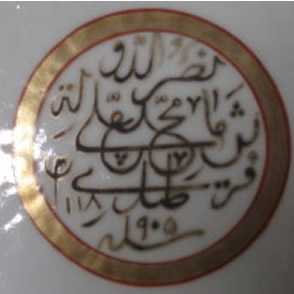Can anyone decipher the writing in the photo below? It appears on a set of dishes.

Here’s a recording in a mystery language.
Do you know or can you guess which language it’s in and where it’s spoken?
Riyr va cuirrey kiaull eddyr-Gaelgagh yindyssagh ayn ayns Purt ny h-Inshey lesh kiaulleyderyn voish Mannin, Nerin as Nalbin. V’eh fer vie clashtyn arraneyn as taggloo ayns Gaelg, Yernish as Gaelg Albinagh.
Neithiwr roedd cyngerdd ardderchog ym Mheel efo cantorion a cherddorion o Ynys Manaw, Iwerddon ac Yr Alban. Roedd hi’n wych clywed caneuon a sgwrs yn Fanaweg, Wyddeleg ac Aeleg.
Last night I went to a fascinating lecture in Manx about Venice which covered the city’s history, architecture, transport and much more. It was given by Bob Carswell, a Manx speaker, translator, poet and broadcaster who regularly talks with great enthusiasm about a wide range of topics on his radio programme, Claare ny Gael.
The type of language used and the information discussed was university level, and while I didn’t understand every word, and got a bit lost when he was explaining some of the technicalities of how the city was built, I was able to understand most of the lecture.
One thing he mentioned was the many different terms there are in Venice for streets, lanes, alleyways, etc, including via (street), calle (a walkway between two buildings), calleta (a narrower calle), salizada (a broader calle), ruga (a calle with lots of shops -from French, rue), rio (small canal), rio terrà / terà (filled-in canal), fondamenta (a walkway that runs along a rio or the lagoon), and sotoportego (a covered walkway through a building).
There are also quite a few terms used in street names in English – street, road, lane, alley, passage, close, drive, place, green, croft, way, grove, gardens, end, crescent, bank, and so on.
Is the same true in other languages?
Jea er y vaatey veih Heysham haink mee er caarey aym ta Gaelg eck, ren shin coloayrts as Gaelg, as hoig mee y chooid smoo.
Riyr hie mee dys cuirrey kiaull yindyssagh ayns Purt ny h-Inshey. Haghyr cohirrey ‘Arrane son Mannin’, as va ram kiaulleyderyn schleioil elley ayn.
Ddoe ar y bad o Heysham mi gwrddes i â ffrind sy’n medru Manaweg, naethon ni sgwrsio yn y Fanaweg, a ddealles i y mwyarif.
Neithiwr es i i gyngerdd ardderchog ym Mheel. Roedd y gystadleuaeth ‘Cân i Ynys Manaw’ yn digwydd, a roedd llawer o gerddorion a chantorion yna.
I’m currently in the Isle of Man for the Cooish, a festival of Manx language and traditional music from the Isle of Man, Ireland and Scotland. Last night I went to an excellent concert in Peel which included the Arrane son Mannin (Song for Man) competition, and there’s a lecture in Manx (Leaght y Ghaaue) this evening.
Yesterday I met a Manx-speaking friend on the boat coming over and we talked Manx throughout the crossing. Well actually she did most of the talking and I contributed to the conversation whenever I could. It was the longest conversation I’ve ever had in Manx and I was pleased to find that I could understand almost everything, and even got the jokes.
My Manx tends to get mixed up with Irish and Scottish Gaelic, and even Welsh sometimes, but my friend is fluent in Irish, and speaks some Scottish Gaelic and Welsh, so this didn’t matter so much. We did try to stick to Manx most of the time though.
One of the things we were discussing was false friends between the Gaelic languages. For example, daoine means people in Irish, while in Manx dooiney means men, and the word for people is sleih, mooinjer or pobble. In Scottish Gaelic people is poball or sluagh, and men is daoine.
We also tried to translate Queen’s Bohemian Rhapsody into Manx, though couldn’t remember all the words in English and weren’t sure of the Manx equivalents of some of the words we could remember.
Ta mee goll dys Mannin mairagh er son Y Cooish as ta mee jeeaghyn roym lesh.
Dw i’n mynd i Ynys Manaw yfory am Y Cooish, gŵyl yr iaith Fanaweg, a dw i’n edyrch ymlaen yn fawr ato.
Tá mé ag dhul go dtí an Oileán Mhanann amárach chun Y Cooish, féile an teanga Mhanannais, agus tá mé ag súil go mór lesh.
A language school in Montreal has come up with an interesting way to teach languages – the students get together in local restaurants where the language they’re studying is spoken. This enables the students to learn languages, and about cultures and cuisines, in a relaxed environment where they can actually use what they’re learning. They also get discount on their restaurant bills, and the restaurants get some free advertising, as well as extra business.
Sounds like a good idea.
Do you know of any similar initiatives?
T’eh feayraghey as goll fliugh ayns shoh er y gherrid, agh ta’n ghrian soilshean jiu. Oie Jardain cheayll mee y çhentagyn as hie mee dy akin ad, agh tra haink mee ayns shen va’n jerrey orroo hannah. S’cummey – honnick mee taishbynys çhentagyn yindyssagh ayns Lunnin ayns Mean Fouyir.
Mae hi’n mynd yn oerach ac yn wlypach yma yn ddiweddar, ond mae’r haul yn disgleirio heddiw. Nos Iau mi glywes i’r tannau gwyllt ac es i allan i weld nhw, ond pan gyrhaedais i yno roedden nhw wedi gorffen yn barod. Dim ots – weles i arddangosfa dân gwyllt ardderchog yn Llundain ym Mis Medi.
Tá sé ag éirí níos fuaire agus níos fliche anseo le déanaí, ach tá an grian ag soilsigh inniu. Oíche Déardaoin chuala mé an tinte ealaíne agus chuiagh mé amach chun iad a fheiceáil, ach nuair a tháinig mé ann ansin bhí siad i ndiaidh críochnaithe cheana féin. Is cuma – chonaic mé taispéantas tinte ealaíne go hiontach i Londain i mí Mheán Fómhair.